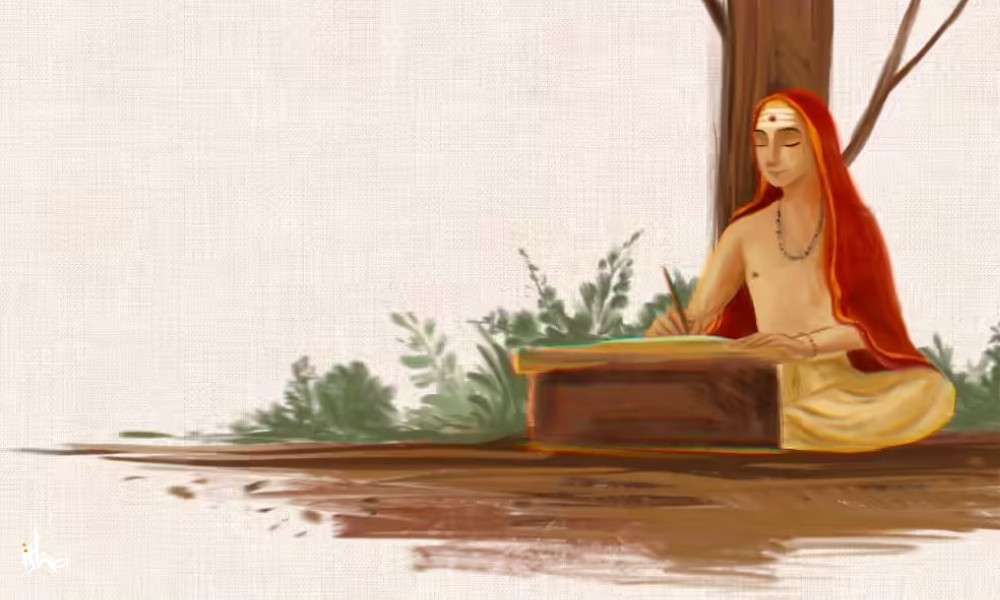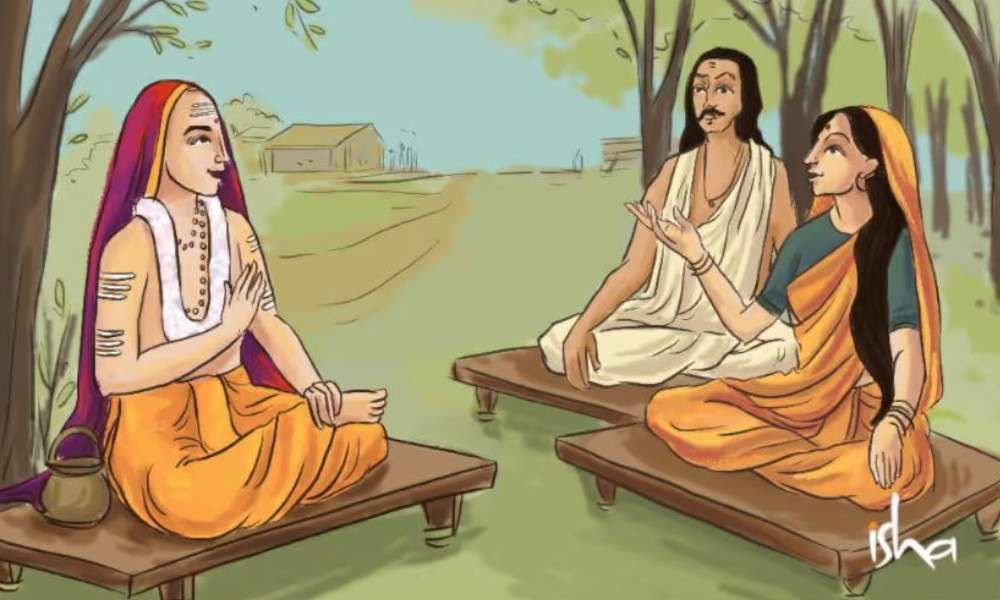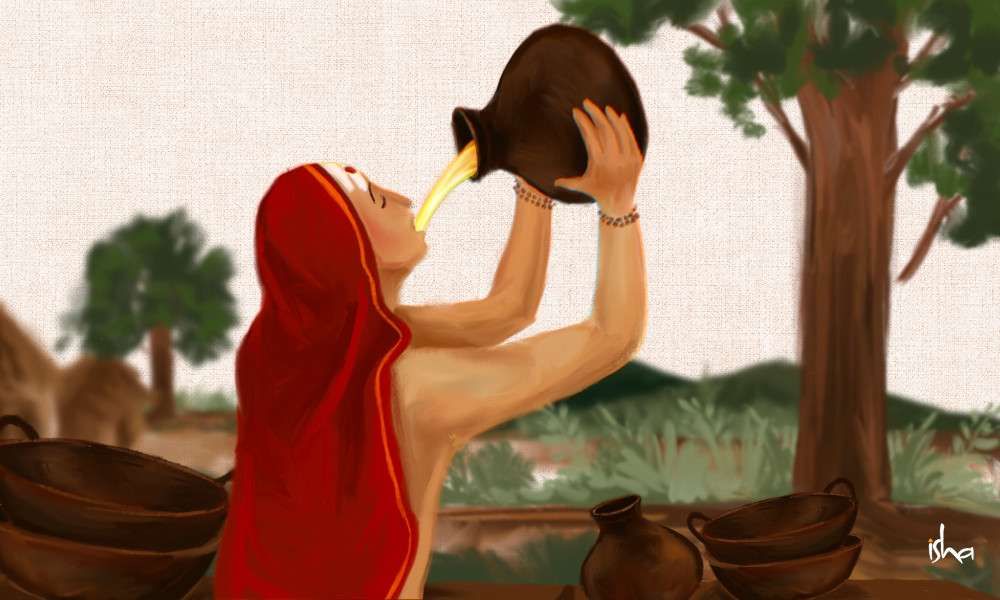Life of Adi Shankaracharya – Stories, Teachings and Stotras
Adi Shankara was a shining spiritual light who illuminated the land of Bharat with teachings that are still as impactful as ever. Sadhguru narrates some spiritually significant stories from his celebrated life.

Adi Shankara - A Prodigy
Sadhguru: Adi Shankara was an intellectual giant, a genius of linguistics, and above all, a spiritual light and the pride of India. The level of wisdom and knowledge he showed at a very early age made him a shining light for humanity.He was a prodigal child and an extraordinary scholar with almost superhuman capabilities. At the age of two, he could fluently speak and write Sanskrit. At the age of four, he could recite all the Vedas, and at the age of twelve, he took sanyas and left his home. Even at such a young age, he gathered disciples and started walking throughout the country to re-establish the spiritual sciences.
By the age of thirty-two, he left his body, but in those twenty years from the age of twelve to thirty-two, he crisscrossed India a few times, north to south, east to west, from Kerala right up to Badrinath and back, travelling everywhere in all directions. The man must have been a really brisk walker to do so much walking in a short span of life, and in between he produced thousands of pages of literature.
The Extraordinary Guru of Adi Shankara
Adi Shankara’s guidance came from Gowdapada. Under his guidance, Shankara went about doing all this incredible work. Gowdapada is very much a part of our tradition also. He was an extraordinary guru, but his teachings were never written down. He made sure it was not written down. He must have taught thousands of people but he produced fifteen to twenty good people who re-established the spiritual science in the country very quietly, without any noise, without starting a new religion or anything. In many ways, that has been the intention of Isha’s work also – not to establish a new religion or a new scripture, but to establish the spiritual sciences just as a way of life, as an inculcation within a human being.
Adi Shankara and Badrinath Temple
Badrinath has historical significance because the temple here was installed by Adi Shankara. He set up his own people there. Even today, the descendants of the families that he set up – traditionally, the Nambudiris – are the priests in the temple. From Kaladi to Badrinath, the distance is more than three thousand kilometers by walk. Adi Shankara walked such distances.
Adi Shankara’s Mother’s Death
Once, when Adi Shankara was up in the North, he intuitively came to know that his mother was dying. At the age of twelve, his mother had given him permission to take sanyas only after he had promised her that he would be there with her at the moment of her death. So when he realized that his mother was ill, he walked all the way back to Kerala just to be with her beside her deathbed. He spent a few days with his mother and after she had died, he walked back north again. When you travel to the Himalayas, you will wonder how anyone could have walked through this. Imagine the effort involved.
How Adi Shankara Entered a Dead King's Body

Adi Shankara got into an argument with a man and won. Then that man's wife maneuvered herself into the argument. Adi Shankara is a certain level of logic – you should not argue with a man like that. But she negotiated herself into the argument, saying, “You defeated my husband, but he is not whole. We are two halves of the same thing. So you must also argue with me.” How can you beat this logic? So, arguments started with the woman. Then she saw she was losing and so she started asking him questions about human sexuality. Shankara said whatever he said. Then she went into more details and asked, “What do you know by experience?” Adi Shankara was a brahmachari (a celibate). He knew that this was a trick to defeat him so he said, “I need a month’s break. We’ll start from where we left off after a month.”
Then he went inside a cave and told his disciples, “No matter what happens, do not allow anybody into this cave because I'm going to leave my body and look for another possibility for some time.” The life energies, or prana, manifest in five dimensions: prana vayu, samana, apana, udana and vyana. These five manifestations of prana have distinct functions. Prana vayu is in charge of respiratory action, thought process and the sensation of touch. How do you check whether someone is alive or dead? If his breath has stopped, you say he is dead. The breath has stopped because the prana vayu has begun to exit. It will take up to one-and-a-half hours for the prana vayu to leave completely.
This is why it was traditionally set up that after the breath stops, you must wait for a minimum of one-and-a-half hours before you cremate someone – because he is still alive in many other ways. We wait for one-and-a-half hours so that his thought process, his respiratory action and his sensations are gone, so that he doesn't feel the burn. Now the remaining part of the prana will still be there. The vyana, the last dimension of the prana, could last up to twelve to fourteen days. The preservation and integrity of the body is largely due to the function of the vyana prana in the system. When Adi Shankara left his body, he left his vyana in the system because his body should be maintained.
It so happened, a king was bitten by a cobra and had died. When cobra venom enters your system, your blood begins to coagulate and breath becomes hard, because when circulation becomes difficult, it becomes hard to breathe. Your breath will stop well before your prana vayu has exited. In many ways, this is an ideal condition for one who wants to enter that body. Normally, it would give you only a window of one-and-a-half hours’ time. But when a person has got cobra’s venom in the system, it will give you up to four-and-a-half hours’ time.
So Adi Shankara got this opportunity and he very easily entered the king’s body. And he went through the process so he could answer those questions experientially. There were some wise people among the king's circle, who, when they saw a man they had declared dead suddenly sit up full of energy, could recognize by his behavior that it was not the same person but someone else in the same body. They sent soldiers all over the city, telling them wherever they saw a body lying around, to burn it immediately – so that if that body belongs to the person who has come here into the king’s body, then he will not be able to leave and go back. Because now the king has come alive – a different guy, but he looks the same, so what? But they did not succeed and Adi Shankara went back.
Adi Shankara Teaches a Practical Lesson to His Disciples!

Once, while walking briskly with a bunch of his disciples trotting behind him, he came to a village. Outside the village, he saw a few people drinking, most likely the country homebrew liquor, which is arrack or toddy. In those days in India, and even up to about twenty-five, thirty years ago, drink shops were only ever outside the village. They were never brought into the village. Nowadays, alcohol is sold in the village, next to your house and in front of your child’s school. Those days, it was always outside the town.
Adi Shankara looked at these few people in their inebriated condition. You know, drunkards always think they are having the best time of their life and everyone else is missing it. So they made some comments at him. Without a word, Adi Shankara walked into the shop, took a pitcher, drank it and walked on.
Behind him, his disciples were trotting and among themselves they started discussing, “When our guru can drink, why can't we?” Adi Shankara was aware of what was happening. When he came to the next village, there was a blacksmith working there. Adi Shankara went inside, picked up the pot of molten iron, drank it and walked on. Now you are not going to imitate him!
Adi Shankara’s Death
Towards the end of his life, Adi Shankara was so established in his culture, his Brahminic way of life and his Vedic knowledge, that he did not see fundamentals properly. One day, he was entering a temple and another person was walking out of the temple. That person happened to be of the low caste, but Adi Shankara was a Brahmin, the purest of the pure. When he was walking into the temple and he saw the person of low caste, he saw it as a bad omen. When he was going to worship his God, this low caste person came in the way. He said, “Move away.” That man just stood there and said, “What should move away, me or my body?” That is all he asked. This struck Adi Shankara so hard, and that was the last day he spoke. He never gave any other teaching. He just walked straight to Himalayas. No one ever saw him again.
What Makes Adi Shankara a Great Being?

How do you produce such a Being? In the brief span of his life, he walked the length and breadth of this nation. Where did this energy, this zest and this wisdom come from? One aspect which is both important and symbolic is that Adi Shankara came from a village called Kaladi, which is a small town today. Kaladi literally means “beneath the feet.” In the South, we are at the feet of Bharat Mata, and this has paid off for us in so many ways.
There is a beautiful story from the Mahabharat. When Arjuna and Duryodhana went to seek support from Krishna for the Kurukshetra war, one of them stood at Krishna’s head, the other chose to stand at his feet – that decided everything. That afternoon, when Arjuna stood at Krishna’s feet, he basically won the war. This is the fundamental nature of our nation and culture – because we bow down to everything, we rise. We do not rise by elbowing our way – we rise by bowing down. Bharat means we always learnt how to be at the feet of the Divine. This is not a culture of pumped up pomp, but a culture of natural piety. Whether it is a god, a man, a woman, a child, an animal, a tree, or a rock – we learnt to bow down to everything. Just with this one aspect, we could produce great beings. By being at the feet of the Divine, we learnt, evolved, blossomed, and became shining lights to the rest of the world for a long time. Thousands of years ago, well before Adi Shankara, right from the Adiyogi, many Yogis, mystics, sages, and saints have said this in so many ways.
It is the intellectual clarity with which he expressed himself and the zest and energy with which he spread it across the nation, that make Adi Shankara stand out. One aspect that is very important in today’s world is that all this knowledge, all this wisdom came not by faith or belief, but by realization. Unless the spiritual process is in some way in sync with fundamental human logic and current scientific findings, people will not take it. Future generations will reject anything that does not make logical sense to them, and is not scientifically correct. In this context, Adi Shankara is very significant today.
Adi Shankara Teachings on Maya - Sadhguru Clarifies
There is some misunderstanding about what Adi Shankara said. I think we owe it to him to clear at least one. A lot of people are saying, “What is this nonsense that he said, ‘Everything is maya.’” The way it is being (wrongly) interpreted is – “maya means it doesn’t exist.” Maya does not mean it does not exist. Maya means an illusion, in the sense that you are not seeing it the way it is. Here you are with this seemingly solid body, but with the food that you eat, the water that you drink, and the air that you breathe, the cells of your body are being exchanged on a daily basis. The tissues and organs in your body completely rejuvenate in a matter of a couple of days to a few years, depending on the type of cells. This means after some time, you have a completely new body. But in your experience, it looks like it is the same thing – this is maya. Similarly, the way you perceive existence, the way you know the world through the five senses, is completely off the mark – this is the illusion. It is like a mirage. If you are driving on the highway, sometimes, far away, there seems to be water. When you go there, definitely there is no water. This does not mean there was nothing there. There was some refraction of light that created this illusion. What is one thing seems to be something else. What you think is “me” is actually everything – this is the maya. What you think is “the other” is actually you. What you think is everything is nothing too. That is the maya that Adi Shankara is talking about.
Adi Shankara’s Teachings – The Creation and Creator Are One
He also said that by knowing the human system, one can know the whole universe. Modern physics is telling you that the entire universe is fundamentally one energy. Similarly, Adi Shankara said that Creation and Creator are one. Today, after a long haul, modern science has come parallel to what Adi Shankara and many sages of the past have stated with utmost clarity.
The Relevance of Adi Shankara in Today’s World
This spiritual wisdom needs to come down from the mountains into the cities, towns, villages, and above all, into the hearts and minds of people. It is time to bring back this culture, this piety and sense of humility that has paid enormous dividend for us – to learn to bow down. This has been our strength, this has been our way, this has been the process and the method of our evolution and realization. This is going to be the greatest treasure – this is going to be the future of the nation. If we do this one thing, the entire world will seek guidance from us. Let us reignite the spirit of Adi Shankara in this country and the rest of the world.
Adi Shankara Stotras
Adi Shankara poured out profound verses that carry the mark of his genius and devotion. It is a true tribute to his wisdom and tireless efforts to raise human consciousness that these verses or strotras are still alive in people’s hearts and minds even after more than a thousand years.
Here are four of Adi Shankara’s most well-known compositions:
#1 Nirvana Shatakam
Nirvana Shatakam is a powerful chant that has become synonymous with the ascetic path over the years. As impactful today as it was when it was first written, these careful arrangements of sounds are a cornerstone of the spiritual process as practiced in the Yogic path.
In this article, find the lyrics, meaning and Sadhguru’s explanation of Nirvana Shatakam and what Adi Shankara is trying to convey through this chant.
#2 Bhaja Govindam
Bhaja Govindam is one of Adi Shankara’s compositions that Sadhguru chants the most. The chant is unique in that it urges the seeker to make it across the ocean of life in whichever way possible. Adi Shankara says that it does not matter how – either through pleasure or through discipline – what is important is that one makes it. Click here for the lyrics of the chant and a short explanation by Sadhguru.
#3 Soundarya Lahari
This beautiful piece of poetry by Adi Shanakara eulogizes the phenomenal power and beauty of creation. This flavorful rendition by Sound of Isha captures the essence of the lyrics and is a tribute to Adi Shankara’s phenomenal craftsmanship:
#4 Pratha Sthuve Parasivam Bhairavi
The song extolls the Devi as the one who sits on the lotus and is the Goddess of words and language. The song was written by Adi Shankara and is rendered by Sounds of Isha on the occasion of Navratri to celebrate the nine days of Devi and appeal to the grace of the divine feminine.
Find the lyrics and meaning of Pratha Sthuve Parasivam Bhairavi in this blogpost.
Subscribe



